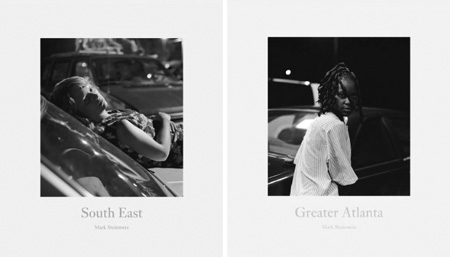Review: South East/Greater Atlanta by Mark Steinmetz

It would seem odd to review Mark Steinmetz’s South East and Greater Atlanta
at the same time, given that the former was already published last year, while the latter is a current release. But it is worthwhile to look at them together - and if I had a copy of South Central
I’d include that, too. The photographer’s website informs us that South East
covers the years 1994-2001, whereas Greater Atlanta
was shot over a slightly longer period of time, until fairly recently (1992-2008). Whether or not that is an important detail I am undecided about (it might be a bit academic), but what unites these two books is that it is not very obvious when the work was produced. I’ve heard photographers say that they prefer to work in b/w because it gives more of a timeless look. How much sense that makes is not clear given that people’s clothes or cars or even advertizing in the background usually give away the time. That said, both South East
and Greater Atlanta
do not easily give away their time periods (while I looked at one of the books, my wife kept guessing, not very successfully).
Of course, there is another sense of timelessness, namely the one where a body of work just stays fresh, where it doesn’t just cover, for example, some time period’s folly, but speaks directly about the human condition, in ways that are probably impossible to define (even though plenty of art critics and art-school academics have created careers out of trying anyway). That is the realm of South East and Greater Atlanta
- I am convinced that this work will easily stand the test of time and reveal itself in completely new ways for many years to come (instead of telling us something we already discovered). Of course, this kind of timelessness is not something you can get by making a choice about the film - you either know how to do this, or you don’t.
I shouldn’t be saying this, but I wish that at least South East was done in colour, though. South East
focuses heavily on portraiture - Greater Atlanta
has a much larger fraction of landscapes - and I would have loved to see those portraits in colour. I can’t help it - I love colour! I know, b/w has all the subtle shades of grey - but colour adds all those little details in different way. However, given the strength of the books’ portrait work, I’m acting a little bit like the spoiled child that most critics really are. And I’m happy to add that in the end, whether or not the work is in colour of b/w is meaningless, because that is not what matters. What matters is the strength of the work, a strength that is derived from a photographer’s ability to connect with his subject matters, to produce work that looks truly effortless. There is an amazing lightness about this work.
One of the things I noticed about these books is that most of my photographer friends own them and love them, and that includes many artists working on portraiture, many artists with vast collections of books. It’s almost uncanny how many of them pulled out South East to show me as an example of a book that I just had to have. I don’t know why this would/should influence your decision about whether or not to buy one of the books (or both). I can assure you, though, that this doesn’t happen all the time - quite on the contrary.
If I had to pick one I’d suggest buying South East first, but that might be my bias for portrait work. I’m not good at these kinds of predictions, but with editions of 1,000 each, I’m expecting South East
to sell out first, given it was already published last year.
These kinds of considerations aside, both South East and Greater Atlanta
are must buys for any serious follower of contemporary photography. You will be coming back to them often.